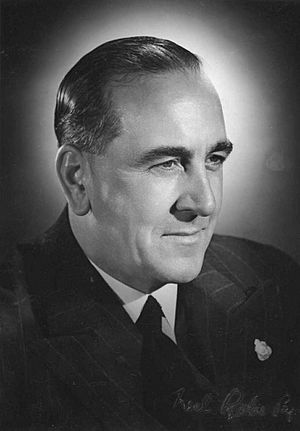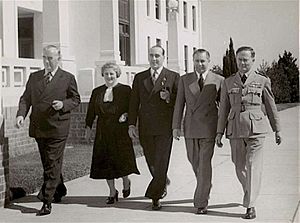Eric Harrison facts for kids
Quick facts for kids
Eric Harrison
|
|
|---|---|
 |
|
| Deputy Leader of the Liberal Party | |
| In office 21 February 1945 – 26 September 1956 |
|
| Leader | Robert Menzies |
| Preceded by | Party established |
| Succeeded by | Harold Holt |
| Leader of the House | |
| In office 11 May 1951 – 26 September 1956 |
|
| Preceded by | Office established |
| Succeeded by | Harold Holt |
| Deputy Leader of the United Australia Party | |
| In office 14 April 1944 – 21 February 1945 |
|
| Leader | Robert Menzies |
| Preceded by | Billy Hughes |
| Succeeded by | Party abolished |
| Member of the Australian Parliament for Wentworth |
|
| In office 19 December 1931 – 17 October 1956 |
|
| Preceded by | Walter Marks |
| Succeeded by | Les Bury |
| Personal details | |
| Born | 7 September 1892 Surry Hills, New South Wales, Australia |
| Died | 26 September 1974 (aged 82) Chatswood, New South Wales, Australia |
| Political party | UAP (1931–45) Liberal (from 1945) |
| Spouses |
Mary McCall
(m. 1920–1941)Linda Yardley
(m. 1944) |
| Children | 3, including Shirley Walters |
Sir Eric John Harrison (7 September 1892 – 26 September 1974) was an important Australian politician and diplomat. He was the very first deputy leader of the Liberal Party from 1945 to 1956.
Sir Eric also served as a government minister for four different prime ministers. Later in his career, he became Australia's High Commissioner to the United Kingdom from 1956 to 1964. This role meant he was Australia's main representative in the United Kingdom.
Harrison was born in Sydney and left school when he was 13 years old. He fought in the Australian Army during World War I. After the war, he managed a textile factory. In 1931, Harrison was elected to the House of Representatives, representing the United Australia Party (UAP).
He held several important jobs in the government, including roles related to defence. In 1951, he became the first Leader of the House. Harrison left politics in 1956 to take on his role as High Commissioner. He retired in 1964. His daughter, Shirley Walters, also became a politician, making history as the first woman to represent Tasmania in the Senate.
Contents
Early Life and Military Service
Eric Harrison was born in Surry Hills, a suburb of Sydney, New South Wales. His mother was from Ireland, and his father, who was a painter, was from England.
Eric went to Crown Street Superior Public School. He left school at age 13 to start working in the textile industry. He eventually became a factory manager.
In October 1916, Eric joined the Australian Imperial Force during World War I. He served on the Western Front from December 1917. He was promoted to sergeant in May 1918. After the war, he returned to Australia and married Mary Cook McCall in 1920.
Political Beginnings
Eric Harrison wasn't involved in politics before 1931. However, in that year, he helped start a local group for Joseph Lyons' All for Australia League.
In the December 1931 elections, he won the seat of Wentworth in the House of Representatives. Both he and the person he defeated were supported by the United Australia Party (UAP).
Early Government Roles
On 12 October 1934, Harrison became Minister for the Interior. He held this job for a short time. In November 1938, he became a minister without a specific department, looking after Australia's territories.
In April 1939, he was appointed Postmaster-General. This role was in Robert Menzies' first government.
World War II and Leadership
During World War II, Eric Harrison continued to serve in government. In October 1940, he became Minister for Trade and Customs. He made decisions about important resources, like newsprint for newspapers.
Harrison was a strong supporter of Robert Menzies, who was Prime Minister. When Menzies' government lost power in October 1941, Harrison moved into opposition.
In 1940, Harrison became an officer in the Militia, which was a part-time military force. In 1942 and 1943, he worked full-time with the United States military forces in Australia.
His first wife passed away in 1941. In October 1944, he married Linda Ruth Yardley.
Becoming Deputy Leader
In April 1944, Eric Harrison became the deputy leader of the UAP. When the Liberal Party of Australia was formed later that year, he became its first deputy leader. He held this important position until 1956. He was the longest-serving Liberal Party Deputy Leader until 2006.
He was also a strong critic of the governments led by John Curtin and Ben Chifley during this time.
Post-War Government Roles
After the Liberal Party won the December 1949 election, Harrison became the third most important member of the government. He was behind Prime Minister Menzies and the leader of the Country Party.
He served as Minister for Postwar Reconstruction and Minister for Defence. From April 1950 to March 1951, he lived in London. In October 1950, he became Minister for the Interior.
In May 1951, he took on new roles as Minister for Defence Production and Vice-President of the Executive Council. He also became the first Leader of the House. From November 1955 to February 1956, he was also the Minister for the Army and Minister for the Navy.
Harrison was even acting prime minister for two weeks in June 1954. This happened when Menzies was in New Zealand and the other leader was recovering from an accident.
Later Life and Legacy
In 1956, Eric Harrison left parliament. He then became Australia's High Commissioner in London. In this role, he represented Australia's interests in the United Kingdom.
The Harrisons returned to Australia in September 1964 and moved to Castle Cove in Sydney. Eric Harrison passed away in Chatswood in 1974. He had been suffering from Parkinson's disease. He was survived by his wife and his three daughters from his first marriage.
One of his daughters, Shirley Walters, followed in his footsteps. She became a Senator for Tasmania from 1975 to 1993.
Honours and Awards
Eric Harrison received several important honours for his service:
- In 1954, he was made a Knight Commander of the Royal Victorian Order (KCVO). This honour was given to him because he was the minister in charge of the royal visit by Queen Elizabeth II. This award is a special gift from the Queen herself.
- In 1961, he was appointed a Knight Commander of the Order of St Michael and St George (KCMG). This was for his excellent work as High Commissioner to the UK.
See also
 In Spanish: Eric Harrison para niños
In Spanish: Eric Harrison para niños


